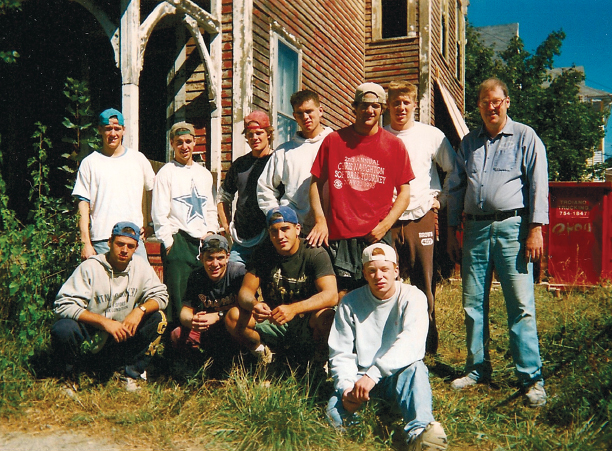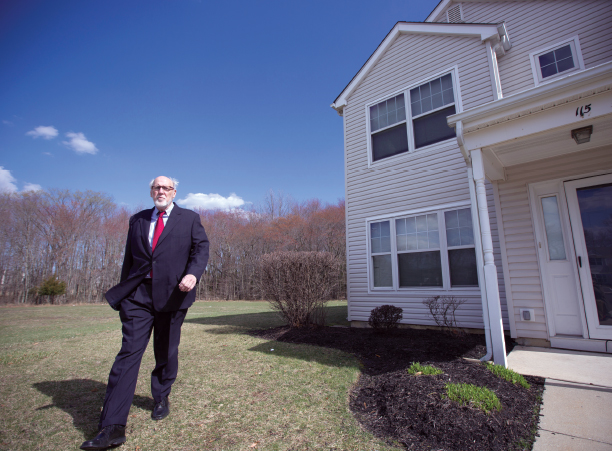In the beginning, all Connie Snow "77 wanted to do was take a few houses — Victorians, once stately but now decrepit — and bring them up to code, creating homes for needy families in Brattleboro, Vermont.
"We were in a period of rapid housing appreciation," Snow says. "There was a feeling the state was losing what little affordable housing we had. A lot of it was privately owned and derelict, and the rest was being bought up by investors."
That was in 1987. Her budget was $7,000.
Exactly 30 years later, Snow would retire as executive director of what became the Windham & Windsor Housing Trust. With an operating budget topping $2 million, the nonprofit has preserved the affordability of almost 900 homes in the region, as well as invested in and rehabilitated historic properties slated for demolition, and reinvigorated downtowns and village centers. The 900 "units" of affordable housing include single family homes, rental apartments, mobile homes, boarding houses and special needs housing, as well as commercial rentals. A Vermont Business Journal story on her retirement termed Snow a "pioneer" in affordable housing "certainly in the state, and probably in the country." The Preservation Trust of Vermont noted: "Downtown Brattleboro would not be what it is today were it not for Connie's efforts."
And Snow well remembers what set her on this path: a Holy Cross course in liberation theology.
"The Jesuits promoted the idea that you shouldn't have to wait until you die for justice — there should be justice here on earth, the right to fulfill your basic needs," she says. "Well, affordable housing is the intersection of the real estate market, construction and social services; that was tremendously exciting for me."
Snow is hardly alone: An array of Holy Cross alumni are devoting their careers, time and treasure to the ideal of housing for all.
The Invisible Problem
In the two generations since Snow left Mount St. James, the nation's affordable housing problem has evolved, affecting different populations and regions in different ways. Nearly the only thing it hasn't done is ease up. While other social issues grab headlines, the struggle faced by millions to simply keep a roof over their families' heads has a way of perennially flying beneath the radar.
Many consider affordable housing an urban concern or one affecting only those receiving government assistance. As such, it's all too easy to dismiss it as one component of the larger entitlement issue, which may seem so vast as to be unsolvable. But Snow's decades of work in two Vermont counties proves affordable housing isn't just a problem for cities, but a rural problem as well. And, it's a problem affecting the unemployed and the employed.
"Some of our tenants are on assistance, but others are working," says Rev. Frederick M. Enman, S.J., founder of Matthew 25, a Worcester-based nonprofit dedicated to providing food and housing relief. He sees the working poor "requiring two weeks' pay just for rent. Sometimes, they're even creeping into that third week."
Enman, well-known as "Fr. Fred," served as a visiting professor at Holy Cross from 1990 to 1994. That's how Worcester became the home of Matthew 25, which Enman and a few friends launched with a yard-sale fundraiser that earned about $1,000; this fall it celebrates its 30th anniversary. With a budget now of $300,000 per year and a ceaseless stream of help from Holy Cross students (more than 1,000 have helped with demolition, painting and everything in between), the organization has renovated and rented 10 homes in Worcester, one in Boston, and tackles a new project every two to three years. Working tenants contribute according to the rule of thumb Enman learned long ago: A week's pay should cover the rent or mortgage.
 Organized by Jonathan White ’96 (front row, third from left), Holy Cross hockey players pitch in at Matthew 25’s 22 Kingsbury St., Worcester, location in 1995. Photo courtesy of Frederick Enman
Organized by Jonathan White ’96 (front row, third from left), Holy Cross hockey players pitch in at Matthew 25’s 22 Kingsbury St., Worcester, location in 1995. Photo courtesy of Frederick EnmanPriced Out, Fed Up
That one-week rule is growing tougher and tougher to follow. By general consensus, the ideal of housing costs comprising 25 percent of one's monthly income has inched up to 30 percent. And according to a 2017 Harvard University study, 40 million Americans have exceeded that 30 percent mark. The nation's homeownership rate has fallen 12 years in a row to 63.4 percent, not by choice, but because consumers are priced out of the market.
Naturally, as rental demand has increased, so too have prices. The Harvard study found "the number of modestly priced units available for under $800 declined by 261,000 between 2005 and 2015, while the number renting for $2,000 or more jumped by 1.5 million."
In a cruel twist, the urgency of putting a roof over a family's head may actually be what pushes affordable housing off the front page. "The struggle can be invisible," Snow says. "The fact that someone pays 60 percent of their income [toward rent] can go unnoticed. But the rent payment (or mortgage payment) is the biggest expense in a family's budget, and if it isn't affordable, tremendous instability can ensue, impacting the health of families, as well as communities." Compounding the issue are massive student loan debt, limiting younger buyers' purchasing power, and skyrocketing health care costs.
Home price growth in the 4 percent range is considered healthy by most economists. For the past two years, prices in the U.S. have grown by 5.1 percent, and they may spike by 6 percent in 2018. That's a problem, because personal income isn't keeping pace (wages grew 2.9 percent last year, according to the U.S. Department of Labor).
According to real estate giant Keller Williams, many builders are frustrated with the rising costs of construction, skilled labor and land. They've responded by abandoning starter homes, shifting into the luxury market. As a result, Keller Williams estimates the market is missing 2 million homes that were never built.
A Moving Target
The struggle to provide affordable housing dates to a tumultuous time in the nation's history. "When I started [working on the issue] in the late 1960s, the major challenge was racial discrimination," says Peter J. O'Connor '63. "Many urban centers had just faced riots. A lot of whites were moving to the suburbs — and they were not inviting minorities. They created barriers through exclusionary zoning and planning. The challenge was to change that, and we chose the legal route."
After earning a Georgetown law degree, O'Connor — a 2003 Sanctae Crucis Award honoree — returned to his home state of New Jersey and has spent the ensuing half-century battling for affordable housing. He was co-counsel in a pair of landmark New Jersey Supreme Court decisions known as "Mount Laurel I (1975)" and "Mount Laurel II (1983)." Essentially, the court decisions — which focused on income rather than race, a first in the U.S. — dictated that when a municipality uses its planning and zoning powers, it must use them for the general welfare. "Including," O'Connor notes with an understandable note of triumph, "the welfare of low- and moderate-income citizens."
 Peter O'Connor '63 at the Fair Share Housing Development in Mt. Laurel, New Jersey. Photo by Todd Plitt
Peter O'Connor '63 at the Fair Share Housing Development in Mt. Laurel, New Jersey. Photo by Todd PlittDespite the considerable challenges, there have been many victories in the battle for affordable housing. For example, Enman and O'Connor agree that overt racism has receded (though not, by any means, vanished).
Where "white flight" from cities was the name of the game two generations ago, the reverse is now more likely to be true: Gentrification of urban areas drives prices up and tenants out.
That's what prompted Christine Barber '98 to roll up her sleeves. Barber, who graduated Holy Cross with a degree in sociology, is a state representative from Massachusetts' 34th Middlesex District, an area that includes Somerville and Medford — two rapidly gentrifying towns near Boston.
"Sale prices [in my district] are up 60 percent in the last five or six years," Barber says. "Rent is up 40 percent since 2011." The problem prompted her to join the state legislature's Joint Committee on Housing, where she has learned "there's no easy solution."
But that doesn't prevent Barber from trying. "We're taking steps to increase the building of multifamily housing," she says. The bill she's pushing would ensure such housing was part of any larger development project and suitable for its proposed tenants: close to transit and amenities, walkable and accessible.
Sen. Bob Casey '82 (D-PA) would applaud Barber's measure. "Among our most pressing challenges right now," he says, "is working to advance legislation that provides resources to low-income families, as well as older Americans and those living with disabilities."
The Spark
Just as a liberation theology course set Snow on her path, other alumni recall similar moments of clarity.
Remember those 1,000-plus students who've donned boots and work gloves to help Enman demo Worcester homes? It turns out Barber was one of them. "Yes!" she says when informed Enman is still at it. "I interned with Matthew 25 one summer. They do such great work there." For her, the highlight was meeting the families who would eventually occupy the homes.
O'Connor first sensed something amiss when he was an all-state hoopster in Newark, New Jersey. "Most of the players were black," he says. "Afterward, they would go [home] in one direction, and I'd go off in the other. I realized this was not an accident. I wanted to do something to change this." Holy Cross, where he continued his basketball career in impressive fashion — co-captain in his senior year and active member of two Crusader teams that played in the NIT, then the nation's top tournament — sharpened the message and gave the political science major the tools he needed. "What Holy Cross taught was values, perseverance, justice," he says.
Casey says both the College itself and his subsequent experience with the Jesuit Volunteer Corps "had a profound impact on the way I look at service. I put names and faces to the families and communities struggling to make ends meet and was able to see the good this commitment to others can do."
There is no laurel-resting among those in the Holy Cross community who've labored for affordable housing. Quite the opposite: They view every victory as a mere toehold for the next thrust upward. Regulations and land cost are now significant obstacles, and many say the next challenge is to integrate social services into affordable complexes; otherwise, the deck is stacked against the tenants.
But that doesn't prevent advocates from remaining determined, even optimistic: "There are no shortcuts," Barber notes. "But there are ways to build more housing that could benefit the neediest and help us live out our values."
Written by Steve Ulfelder for the Fall 2018 issue of Holy Cross Magazine.
About Holy Cross Magazine
Holy Cross Magazine (HCM) is the quarterly alumni publication of the College of the Holy Cross. The award-winning publication is mailed to alumni and friends of the College and includes intriguing profiles, make-you-think features, alumni news, exclusive photos and more. Visit magazine.holycross.edu/about to contact HCM, submit alumni class notes, milestones, or letters to the editor.


